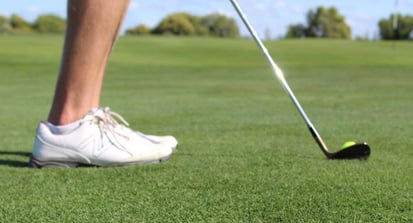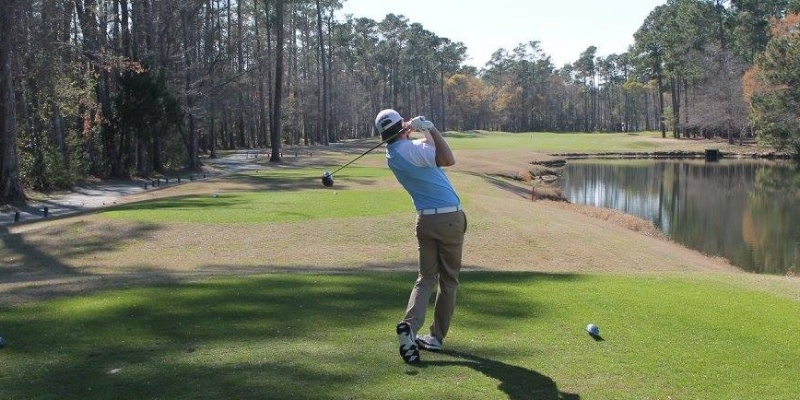If you've looked into buying or upgrading golf equipment lately, you might have noticed the process can seem like being in 11th grade physics class all over again. There's certain golf equipment terms thrown around by club fitters, sales associates, and PGA Tour analysts that you might not understand.
The simple fact is that club fitting and technology come down to one simple equation; Does it help your golf game and what are the benefits? I want to break down the barrier between Research and Development departments and the great unknown of golf-specific equipment terms that may confuse the buying process. Let’s take a look at a few common golf equipment terms that, when understood properly, will lead you to shooting better scores and having more fun on the course!
1) Bounce angle
 Everybody knows that they have bounce on their clubs, but why? Bounce of the club is the angle of the sole against the ground when you are at address. Having bounce on your clubs limits the amount the front edge of a club digs into the ground at impact.
Everybody knows that they have bounce on their clubs, but why? Bounce of the club is the angle of the sole against the ground when you are at address. Having bounce on your clubs limits the amount the front edge of a club digs into the ground at impact.
For most golfers, having bounce on their wedges allows the player to make the optimal shot for the lie. “High bounce” wedges, like what you may find in your sand wedge, will allow the club face to slide throughout the shot, promoting a softer, higher shot out of lies in the sand, rough or around the greens.
Choosing the right bounce for you is important. Many tour pros and low handicap golfers may opt for a tour sole or low bounce because of the tight lies on pristine golf courses. Whatever you choose for wedges, make sure you select the right tool for the job. Like choosing a philips head or a flathead screwdriver, having the right tool for the job (or shot) is just as important as any golf buying decision.
2) Compression
You hear it a lot around the golf world: "What compression is my golf ball?" 100? 90? Golf ball compression is an important part of choosing the right golf ball for your game. Whether you plan to play a softer 3 piece ball or perhaps a tour performing ball like the Srixon Z-STAR or Z- STAR XV, choosing the right ball can lead to better scores.
Compression of the golf ball is measured by a numerical value assigned to how much the ball will compress. Compression of the golf ball is measured by how much force it takes to “flatten” the golf ball. On the numerical scale, a higher compression ball would be 100 where a low compression ball will be around an 80. A higher compression ball is typically reserved for stronger players, higher swing speeds. A lower compression ball conversely will flatten more, adding distance to swing speeds that may not be as high. A softer compression golf ball may offer more feel around the greens and off wedges. A higher compression ball typically offers more control.
3) Swingweight
We often see the swing weight values on our clubs, or when looking to purchase new clubs. I would be willing to bet that this number means nothing to the vast majority of golfers. What I would insist is that this number, although appearing confusing, may be a simple way to understand how your club “feels”.
Swingweight is measured on an alpha-numerical scale. Think of swingweight as the relationship between the weight in the bottom 2/3 of the club to the top 1/3. With a sliding scale fulcrum, club fitters are able to assign a value for swingweight based upon numbers and alphabet letters from A-F. The larger the number and closer to F you get, the heavier the swingweight of the club. Achieving the optimal swingweight will help lead to more consistent feel throughout the set and lead to making a smoother, more consistent swing. Staying balanced, on plane, and balancing weight throughout the set of clubs will help your game.
4) MOI (Moment of Inertia)
 Moment of inertia (MOI) is a phrase that is really popular in club marketing. Giants of the golf manufacturing industry have touted their clubs having high moments of inertia for playability across all skill levels. What does this mean exactly?
Moment of inertia (MOI) is a phrase that is really popular in club marketing. Giants of the golf manufacturing industry have touted their clubs having high moments of inertia for playability across all skill levels. What does this mean exactly?
MOI is a term in physics that refers to how resistant an object is to twisting. When you have higher amounts of MOI, the more resistant that object is to being twisted. Sounds like physics class again? Simply put, this figures helps measure how “forgiving” the club is at impact?
Let’s face it, not all of us are ball strikers like the people on tour. We need something that promotes confidence and can be forgiving on off-center hits. The majority of amateur players do not hit the center of the club face with any sort of high percentage consistency, that is why a high MOI club will offer more distance and straighter ball flight on off center hits. Moving weight towards the perimeter of the club and away from the center of gravity will lead to higher MOI.
5) Kick point
Kick point in a golf shaft is where the shaft naturally bends and stores power in the swing. Kick point in the shaft helps dictate the trajectory of the shot coming off of the club face. To give an example on how kick point works, increasing the tip stiffness in a driver shaft will lead to a higher bend profile in the shaft. This will produce a higher kick point thus promoting a lower launching club.
The term “kick point” is becoming somewhat of an antiquated term in golf fitting and tech talk. The players using the clubs are much more concerned about launch angle and ball speed. The launch angle in the shot is the primary driver behind determining the height and distance of any shot.
Bonus: Launch Angle
The vertical angle relative to the horizon of the golf ball’s center of gravity movement directly after leaving the club face!
Keep in mind that these may be oversimplified explanations of complex golf terms in club fitting and optimizing your game. The goal is to break down the barrier of the physics lab and the best product that may match your game. If you have specific questions related to club fitting or equipment that may be right for your game, contact me at connor@nextgengolf.org.









